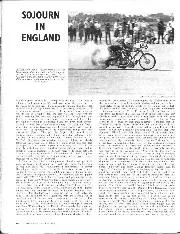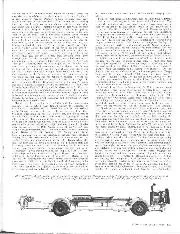

SOJOURN IN ENGLAND
SOJOURN IN ENGLAND ACCRI,ERATION.—Hagon leaving the start line at Santa Pod in a cloud of wheel-spin smoke on one of his under-so-second runs. In the nose-cone is the fuel tank,…
TWO H ME-BUILT HYBRIDS An Amateur’s Efforts at Car Building.
• N the early. days of the motor-car I and its now defunct offspring, . the cyclecar, home-made ve
hicles were quite common, but the Introduction of cheap and serviceable mass-produced cars has reduced the ranks of amateur builders to an almost negligible quantity so that rare and nameless hybrids are scarcely ever seen. Nevertheless, the construction of a
motor from odd bits and pieces is an absorbing and amusing pastime for the man who is mechanically minded, and with the second-hand market in its present state, it is one which does not entail much layout of hard cash. Realising this, the writer decided to try his hand at the game, and after a judicious search in junk yards and the darker corners of
local garages eventually secured something which was to form the basis of his own ” special.” This was a Waverley chassis which had been built up to try out a six-cylinder single sleeve valve engine on the track. Owing to a change of policy this idea was not carried out ; instead, a four-cylinder engine of similar type and of 11-litres capacity was installed, and it was in this condition when the writer acquired it, the whole chassis being almost unused. A few days hard work with wood and sheet aluminium produced what was intended to resemble (and did to some extent), a four-seater Le Mans type of body. During the succeeding weeks such necessary articles for this climate as mudguards, wind-screen, and hood were added, lighting set completed, some dark red Robbialac applied, and the motor was more or less serviceable. Its appearance was rather imposing, the wind-screen being 6 feet from the radiator cap and but 41 feet from the stern. The effect was somewhat spoilt by opening the bonnet to disclose a comparatively minute engine ! The body was equipped with Sorbo sponge upholstery, tonneau and hood covers, while the dashboard carried speedometer, clock, rev, counter, oil gauge„ and radiator thermometer. To complete the car, duplex
Hartfords were installed all round, and Whitehead type front brakes fitted, operated in conjunction with one pair of rear brakes by a lever outside the body, the remaining pair of brakes being connected to the pedal.
The performance hardly did justice to the appearance, though as serious competition work was never intended no great disappointment was felt. The gear ratios were 31, 6, 1 1 , top gear giving 25 m.p.h. per 1,000 r.p.m. As the engine gave but 30 b.b.p. at 3,000 r.p.m., it will be seen that it was somewhat stifled—about 42 m.p.h. was attainable in 2nd gear, and on engaging top it was always a moot point as to whether the car would gain speed or not ! A headwind invariably produced
deceleration down to forty, no wind and a level road realised about 48-50, while downhill with a following gale, 65 or mo:e was attainable ! Still, it was an amusing car to drive, its low build, short wheelbase, and light steering making it extremely handy, a point which has always tarried more weight with the writer than high speed.
In this guise the car was run throughout 1927 and went through several adventures, the worst moment being during a practise ran in some speed trials at Hatley Park, near Cambridge. Breasting the rise at about 50 disclosed a motorcyclist astride a stationary machine across the narrow road, apparently deaf and entirely oblivious of our approach. At this time the front brakes were not fitted, and the only hope was hard braking, resulting in a broadside skid which took the car on to the grass beside the road, where we stayed.
Vauxhall engine installed.
Towards the end of the year the writer’s irritation at the lack of power grew to unbearable dimensions, and after some search, a 20 h.p. “Prince Henry” Vauxhall engine was unearthed, dating from 1912, and was purchased, with a four-speed gearbox for £8. Some hard work saw this installed, and the motor was on the road again by January, 1928. This engine proved an amusing contrast : it was reputed to develop 40 h.p. at 2,000 r.p.m., and was distinctly undergeared—its pulling power was tremendous, and a cruising speed of about 48 was not too much for it.
The maximum obtainable was about 62, but this invariably resulted in a broken valve so was seldom utilized ! Of course, the consumption was poor-15 m.p.g. of petrol and 150 m.p.g. of oil proved expensive, and it was chiefly for this reason that an offer of £10 for the engine was accepted in September of that year. The tenner served to purchase and overhaul an old G.N. which served as a hack while the writer was engaged on other work until Christmas, when further leisure and an inspection of ” stock” induced him to commence the construction of a “sprint model” with a view to the 1929 Inter-Varsity Hill-Climb. The stock consisted of the G.N., the 1 Hitre sleeve valve engine out of the other chassis, a Benjamin radiator, and a scrap-heap ! The G.N. engine, windscreen, and hood were exchanged for a wide track front axle and some extra front springs. The 4-cyl. engine was mounted in the chassis by its rear bearers and a bolt through the starting handle bearing, the G.N. side-starting gear being • retained instead. To save machining, the Waverley clutch was retained and the propellor shaft shortened to suit. The front springs were duplicated, and the back reset with a negative camber, so that the bevel box was about 6 inches from the ground, the chassis sloping considerably towards the rear. This layout, of course, made it impossible to swing the starting handle without jacking up the frame at the side, but the engine could usually be started on a pullover through the 31 to 1 bevels. A “Manx “body was built of stringers,
aeroplane fabric and dope, so designed as to disguise the sloping chassis. The petrol tank held 6 gallons and was carried in the tail, fuel feed being by hand pressure pump. The dash carried only speedometer, oil, and air pressure gauges. The car was generally known as the “1k model,” both on account of its cylinder capacity 1.nd its seating accommodation ! Two sets of gear ratios wf.,,re available, 3.4, 4, and 7.3, or 4, 5.8, and 7.3, the former for touring, the latter for sprints. For this purpose a special 21t. sprocket was made and bolted to the hub of a standard 36t. sprocket by six 1 inch studs—sliding this duplex sprocket and altering the length of the chain gave the alternative ratios of 3.4 or 5.8: the other two were never disturbed. As the total cost of this conversion was about £15, some satisfaction was felt when it secured 3rd in the 1,500 c.c. racing class and 4th fastest car time of the day at Branches Park, in February, 1929.
Another power unit.
Shortly after this the other chassis was taken in hand again. A sixcylinder sleeve valve engine, of the type the chassis was originally built for, was purchased from Argylls of Glasgow, with a unit four-speed gearbox. This unit was installed without much difficulty, except that the bracket for the right-hand gearlever occupied all the space available on the car for the driver’s feet, so the bracket was cut off and a central ball-mounted lever was designed and fitted. The braking system was altered so that the pedal operated the front’ brakes, the rear brakes remaining connected to the hand lever—the system used on the 1924 Aston-Martins. The car was now capable of about 70 m.p.h. and was very pleasant to drive, being almost dead silent, both mechanically and as regards exhaust system. Unfortunately, as the writer then had to turn his attention to other and more lucrative pursuits, certain details remained unfinished, and a year of hard work and neglect made the car somewhat decrepit, and it had, regrettably, to be exchanged for something less pretentious and more economical which will have to last until sufficient money and leisure are available to give him a chance to try his hand again.—H.P.B.